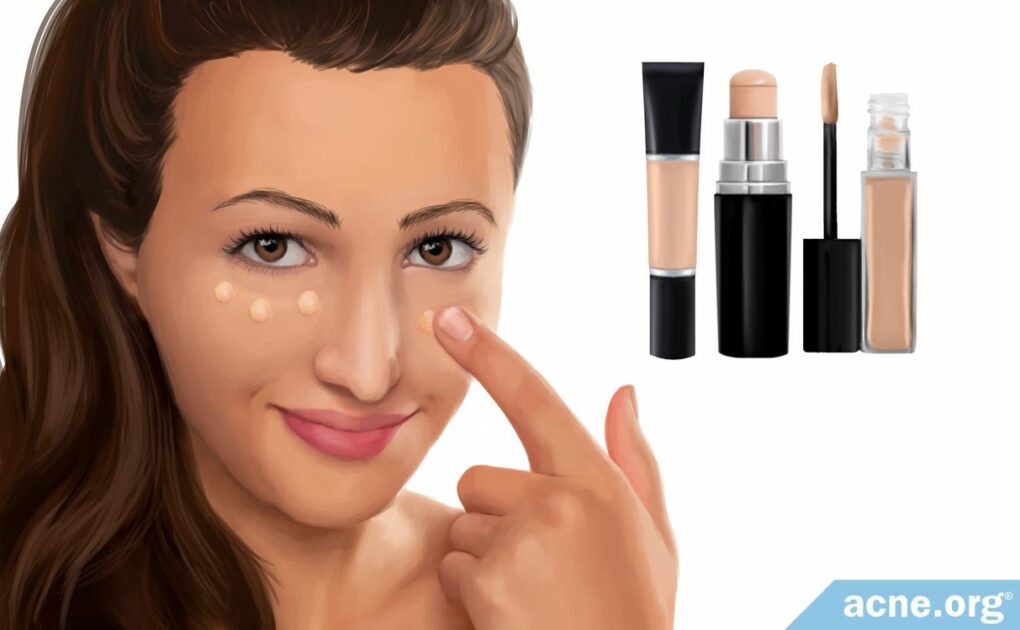Select a Concealer That Does Not Contain Pore-clogging Ingredients and Apply It Gently

The Essential Info
Before buying any concealer for acne-prone skin, look at the list of ingredients. Avoid concealers that contain pore-clogging ingredients.
In addition, opt for fragrance-free concealers, because fragrances may irritate the skin or may cause allergies in some people.
A concealer specifically made for acne-prone skin, which normally means it contains a small amount of salicylic acid may be preferable if you can find one.
Some concealers have a green undertone. Because green is a complimentary color to red, green-tinted concealers can help mask the redness of acne lesions.
Important Considerations When Using Concealer
- Apply it gently: Apply concealer very gently to avoid irritating the skin.
- Remove makeup before bed: The skin is more vulnerable at night. Remove all makeup very gently before you go to bed.
- Don’t use expired makeup: Use only fresh makeup.

The Science
- Guidelines for Choosing a Concealer for Acne-prone Skin
- List of Common Comedogenic (Pore-Clogging) Ingredients in Makeup
- Tips for Using Concealer on Acne-prone Skin
A concealer, also known as a color corrector is a makeup product that evens the skin tone by covering minor skin imperfections, such as:
- Acne lesions
- Blemishes or hyperpigmentation
- Dark circles under the eyes
- Large pores
- Age spots
Concealer is similar to foundation, but is typically thicker and contains a larger amount of pigment. People usually apply concealer on its own to cover a specific imperfection, or apply it under foundation in particular areas that require more coverage.1-3
Since some makeup products can potentially trigger or worsen acne,4 finding the right concealer for acne-prone skin can be challenging.
Guidelines for Choosing a Concealer for Acne-prone Skin
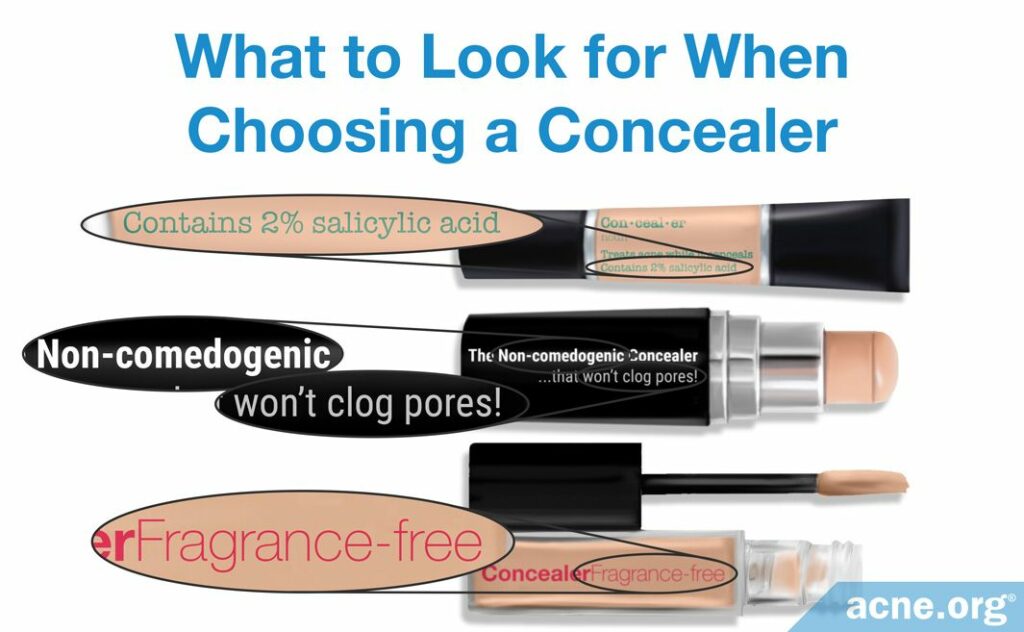
- Avoid pore-clogging ingredients: Before buying a concealer, take a look at the list of ingredients. Avoid concealers containing pore-clogging (comedogenic) ingredients. The table below provides a comprehensive list of common comedogenic ingredients.
- Look for a fragrance-free concealer: Some concealers contain fragrances, which are the ingredient most likely to cause allergies. Even if you are not allergic to fragrances, they may irritate your skin and thus make acne worse. The best strategy is to select a fragrance-free concealer.
- If possible, find a concealer made specifically for acne: Some manufacturers produce concealers for acne-prone skin by adding salicylic acid, which is an anti-acne ingredient that is somewhat effective. The concentration of salicylic acid in over-the-counter products like makeup is low, so it is unlikely to lead to a dramatic improvement in acne. Still, it may be a good idea to opt for a concealer with this ingredient if you can find it.
- Consider choosing a concealer with a green undertone: When looking for a concealer to cover pimples, consider selecting a product with a green undertone. The green tint will cancel out the redness of the pimple, creating a neutral skin tone. Alternatively, opt for a concealer that is a shade or two lighter than your natural skin tone so that it effectively masks blemishes.1,3
- Do not worry about looking for a concealer that contains sunscreen: Although some concealers do contain sunscreen, most people do not apply enough concealer to adequately protect the skin from the sun. Therefore, it is not worthwhile to search for a concealer containing sunscreen. However, if you spend a lot of time in the sun, it is important to protect your skin from the sun’s rays by wearing a separate sunscreen product, primer, or foundation that contains broad-spectrum sunscreen.
List of Common Comedogenic (Pore-Clogging) Ingredients in Makeup
Many scientific studies have looked at how likely various ingredients are to cause comedones (clogged pores).4 We have combed through this research and compiled two lists:
- Definitely avoid: These are ingredients that people with acne-prone skin should definitely avoid, because a convincing amount of evidence indicates that they are comedogenic.
- Consider avoiding: These are ingredients that people with acne-prone skin may wish to consider avoiding, because some evidence indicates that they might be comedogenic.
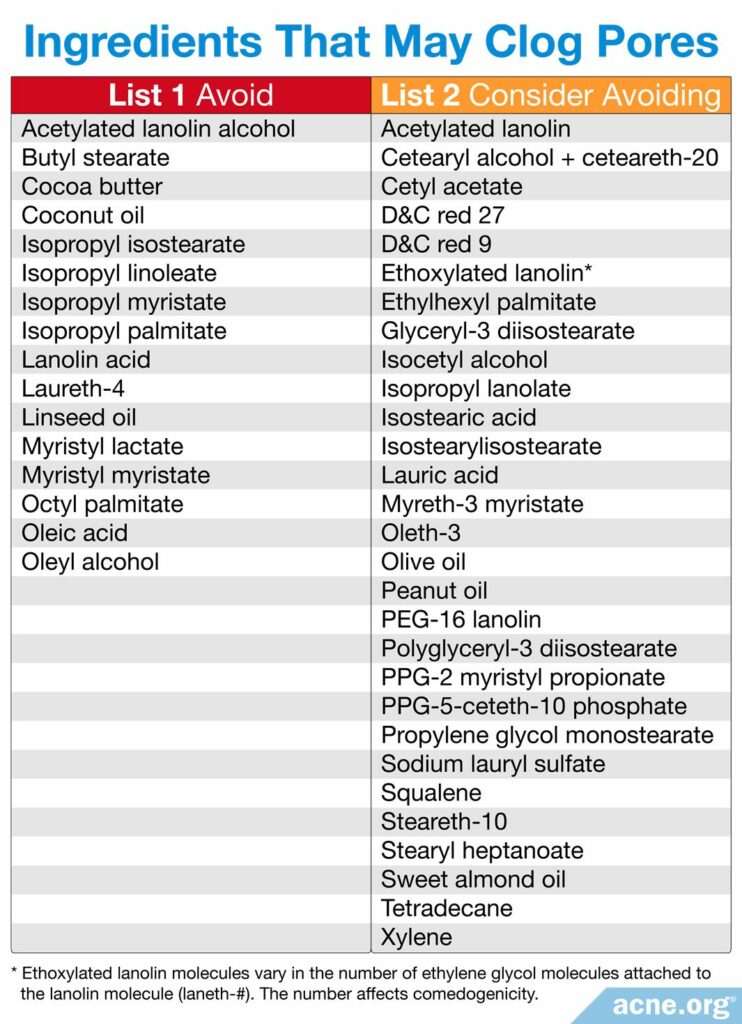
Tips for Using Concealer on Acne-prone Skin
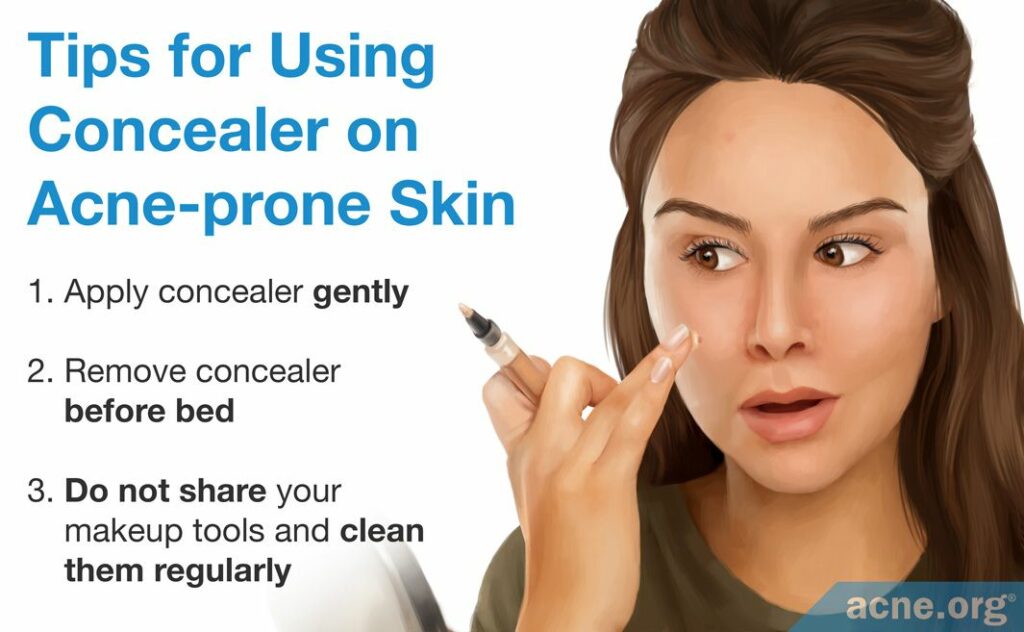
Physical irritation of the skin can worsen acne, so whenever you apply concealer or any other makeup to acne-prone skin, avoid irritating the skin. In addition, it is important to practice good hygiene to reduce the risk of skin infections. Whenever you use concealer on acne-prone skin, keep these tips in mind:
- Apply concealer gently: Traditional makeup sponges can be irritating to the skin. A better option is to apply concealer with the softest makeup brushes or simply with your fingertips. Always apply makeup gently to avoid irritating the skin.
- Remove concealer before bed: Since the skin is more vulnerable at night, it is good practice to remove concealer and any other makeup before you go to bed. Remove cleanser gently so as not to irritate the skin.
- Do not share your makeup tools and clean them regularly: Do not share your makeup brush or other tools with anyone, because sharing makeup tools increases your chances of catching a skin infection. Using disposable tools or cleaning your tools regularly will prevent the growth of mold and bacteria.
Concealer Ingredients: The Full Scoop
Concealer or color corrector is a makeup product for covering up minor skin imperfections, such as acne lesions, large pores, blemishes, dark under-eye rings, and age spots. Applying concealer to selected “problem spots” allows the skin tone of the face to appear even.1-3
Concealer first appeared on the market in 1954, when the makeup manufacturer Max Factor launched a product called Erace.1
Concealer resembles foundation, but is thicker and contains more pigment. However, concealer is not as thick or as heavily pigmented as camouflage makeup, which is intended to cover up severe skin imperfections like birthmarks, vitiligo, and scars.1
Types of concealer
Concealer can come in liquid, cream, or powder form.1
Some concealers are lightly tinted in a shade that is complementary to the color that needs to be disguised, according to the color wheel. For example:
- A concealer with green undertones can neutralize red blemishes, such as pimples
- A concealer with yellow undertones can neutralize dark blemishes, such as under-eye circles1,2
To apply concealer to acne-prone skin, it is best to use one of the following:
- A soft makeup brush that is flat or has a slightly pointed tip, allowing for precise application
- Clean fingertips
Concealer ingredients
The table below shows the most common types of ingredients in concealer.2 Some of these ingredient types are marked with an asterisk (*) because they may be comedogenic or irritating. Before buying any concealer, always check the list of ingredients and verify that none of them appear in the list of comedogenic ingredients at the beginning of this article.
In addition, steer clear of concealers with ingredients to which you are allergic. If you are not sure whether you are allergic to a makeup product, you can perform a patch test. Place a small amount of product on an inconspicuous patch of skin and wait several hours to see whether you experience skin irritation or itching.
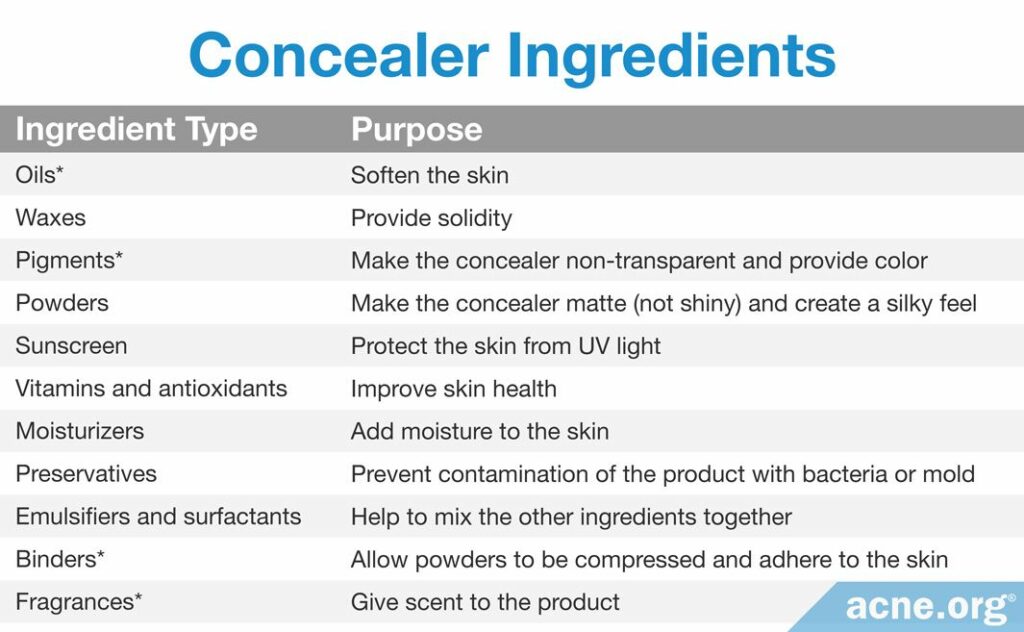
Fragrances in concealer
When it comes to makeup, including concealer, fragrances are the ingredient most likely to trigger allergies.

According to an article published in 2014 in the Spanish scientific journal Actas Dermo-Sifiliográficas, “Fragrances are the most common cause of allergies to cosmetics.”6
Makeup manufacturers prefer not to reveal all the ingredients in their products to prevent copying by competitors. However, according to European regulations, fragrances that tend to trigger allergies in many consumers must always be listed on the label, as long as the concealer contains a concentration of at least 10 ppm (parts per million) of these fragrances.6 These potentially problematic fragrances include:
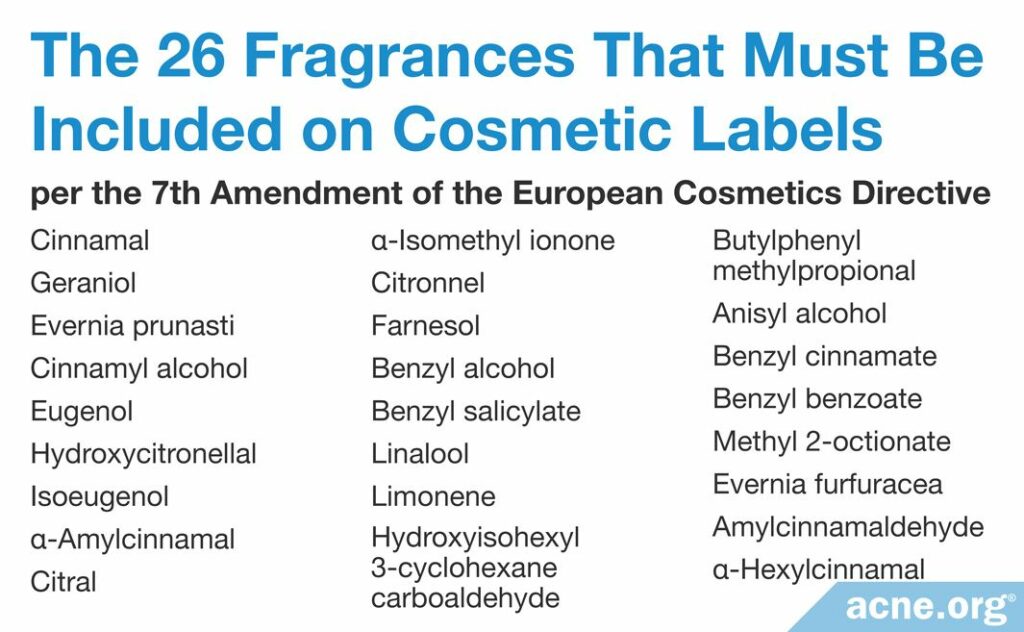
Research suggests that 7.6% of consumers experience an allergic reaction to these fragrances.6
Dermatologists in North America agree with their European counterparts that fragrances in makeup are a frequent cause of allergies. When dermatologists test patients for allergies, instead of testing individual ingredients one-by-one, they usually test mixtures of ingredients that commonly occur in consumer products. So instead of testing whether a person is allergic to any of the hundreds of fragrances out there, dermatologists typically use three pre-made mixtures containing multiple fragrances.7
In other words, experts in Europe and North America agree that fragrances are a frequent cause of makeup allergies. This is why it is preferable to opt for fragrance-free concealer. If you suspect a makeup product may be causing an allergic reaction, perform a patch test on a small area of skin.
Salicylic acid in concealer
Some concealers contain salicylic acid, which is somewhat effective against acne. However, over-the-counter products like makeup are legally only allowed to contain a small amount of salicylic acid: 2% at most. At this low concentration, salicylic acid in your concealer is unlikely to dramatically improve acne. Still, if you can find a concealer with this ingredient, it might be beneficial–but a concealer without this ingredient can be a good choice as well.
Sunscreen in concealer
If you spend a significant amount of time in the sun, protecting your skin from the sun’s rays is a good idea. Excessive sun exposure can cause sunburn, and in people with acne, it can also promote so-called post-inflammatory hyperpigmentation (darkening of acne lesions after they heal). Even if your concealer contains sunscreen, you likely only apply concealer to selected parts of the face, which means that other areas remain unprotected from the sun. Therefore, if you plan to spend a lot of time in the sun, opt for foundation that contains broad-spectrum sunscreen or use a separate sunscreen product in addition to your makeup.
Risks of using expired concealer

A study published in 2013 in the International Journal of Cosmetic Science looked at the use of expired makeup products by 44 students in Brazil. The researchers found that 29.5% of students used expired concealer. The authors also found that expired makeup products are more likely than non-expired products to contain microorganisms like bacteria. They wrote, “The results of this study highlight that microbiological contamination is a serious problem.”5
Always check the expiration date of your concealer and other makeup products, and do not use expired makeup.
References
- Available from: https://en.wikipedia.org/wiki/Concealer. Accessed on 10/08/2017.
- CONCEALER COMPOSITION, United States, Patent Application Publication, Pub. No.: US 2008/0081027 A1, Pub. Date: Apr. 3, 2008.
- Vrcek, I., Ozgur, O., 1 Nakra, T. Infraorbital Dark Circles: A Review of the Pathogenesis, Evaluation and Treatment. Journal of Cutaneous and Aesthetic Surgery, 9, 65 – 72. https://www.ncbi.nlm.nih.gov/pubmed/27398005
- Katoulis A. C., Kakepis E. M., Kintziou H., Kakepis M. E. & Stavrianeas N. G., Comedogenicity of cosmetics: a review. Journal of the European Academy of Dermatology and Venereology, 7, 115-119 (1996). https://onlinelibrary.wiley.com/doi/abs/10.1111/j.1468-3083.1996.tb00606.x
- Giacomel, C.B., Dartora, G., Dienfethaeler, H.S., & Haas, S.E. (2013). Investigation on the use of expired make-up and microbiological contamination of mascaras. International Journal of Cosmetic Science, 35, 375-80. https://www.ncbi.nlm.nih.gov/pubmed/23590385
- González-Muñoz, P., Conde-Salazar, L., & Vañó-Galván, S. (2014). Allergic contact dermatitis caused by cosmetic products. Actas Dermo-Sifiliográficas, 105, 822-32. https://www.ncbi.nlm.nih.gov/pubmed/24656778
- Hamilton, T., de Gannes, G.C. (2011). Allergic contact dermatitis to preservatives and fragrances in cosmetics. Skin Therapy Letters, 16, 1-4. https://www.ncbi.nlm.nih.gov/pubmed/21611680
 Acne.org Products
Acne.org Products